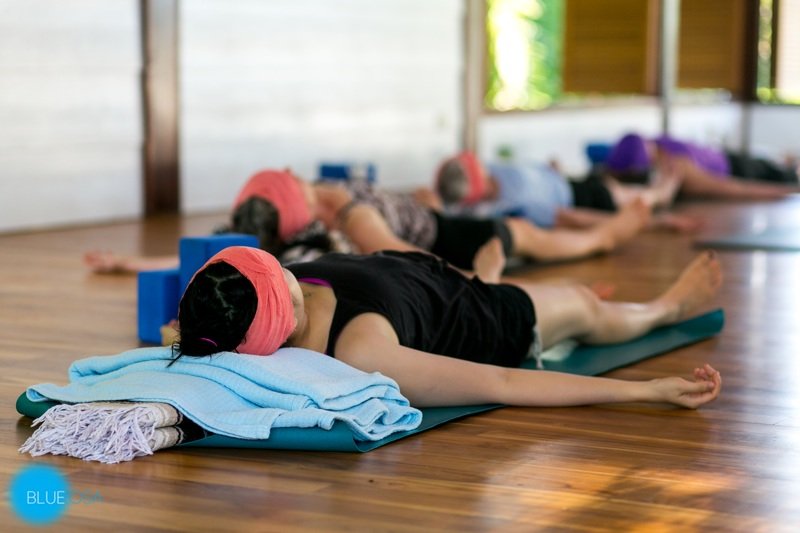If you’re anything like me then when fatigue kicks in you have a tendency to try and push through it, rather than surrender and chill, especially if it goes on longer than a couple of days. I start wondering what’s up and try to pull myself together.
The trouble is, when your energy reserves are depleted and you’re suffering from stress or fatigue our immune system is compromised and nervous system overstimulated. Trying to work out won’t help.
We live in a culture where it now seems to be frowned upon to show any kind of weakness or vulnerability, particularly when it comes to our health. At the first sign of a sniffle or niggle, we’ll complain and pop a pill. We’re not indestructible. We’re human. When germs invade our body we have a highly intelligent mechanism through which we’re able to fight off disease. It’s normal to come down with something every once in a while, it actually means our body is doing what it was built to do. So, why not just go with it and rest? It’s when we pop the pills to mask the symptoms and try to keep going anyway that the real issues begin. We’re spending energy we simply don’t have, leaving us exhausted.
As someone who has learned the hard way I would recommend working in harmony with what you’ve got, rather than forcing and pushing, which will only have you out of the game for longer.
We can help ourselves to cope with stress and fatigue and illness by first pacifying the nervous system, so the body’s natural healing capabilities kick in. When we’re in a state of stress or ‘fight’ (from fight or flight) we’re not able to relax enough for this to occur on its own.
This is part 2 of our Burn Out Series. Click here to read 8 Signs You Are On The Brink Of Burn Out.
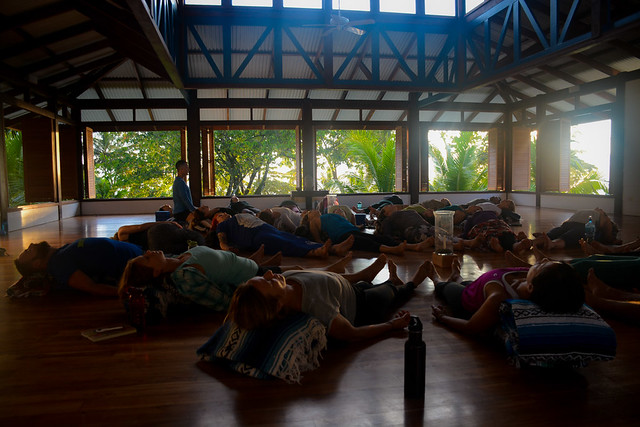
From my own experience with burnout, I have put together the following practice for you to call upon when you feel like you’re running on empty and need to recharge.
When you follow this practice, set aside time when you know you won’t be interrupted. Turn off your cell and unplug the phone, wifi, TV. Create a sacred space for yourself – make sure it’s tidy so you’re not distracted – unroll your mat and have some props to hand; a blanket, a block, a bolster or cushion. Lower the lights and light some candles and incense or an oil burner, using an oil like lavender or rosemary to relax or citrus or peppermint to uplift.
Allow the space to be silent or play soft music, (preferably without lyrics).
The Restorative Yoga Practice for Stress and Fatigue
Keep the practice and your movements mindful. Cultivate your awareness by transitioning from one pose to the next as slowly and quietly as you can, using the minimum about of energy. Whilst laying in the postures repeat to yourself ‘I am relaxing as completely and as fully as I can’ to give yourself permission to let go. Look for areas of attention and breath our any tightness or discomfort on a long, slow exhale.
Watch the breath, keeping each inhalation and exhalation (through the nose) smooth and steady. Allow thoughts to rise and try don’t to judge or react to them, just be where you are.
If you can I recommend pre-recording the instructions and playing them back so you can keep your eyes closed and your attention within.
The Asana Restorative Yoga Practice
- Lay on your back, with your feet flat on the floor and your knees bent (arms along side the body or on the abdomen) in CONSTRUCTIVE REST (10mins)
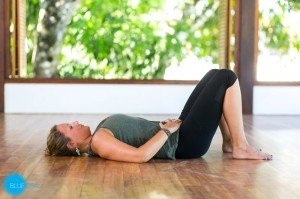
- Hug the knees chest and draw the forehead into the knees as you inhale
- Exhale and return the head and feet to the floor
- Bring the souls of the feet together, close into the groin, press the heals into one another and allow the keens to fall out to the sides in SUPTA BADHAKONASANA (reclined cobbler) / (5mins)
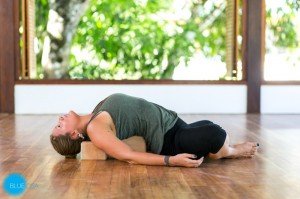
- When you’re ready to release, slowly draw the knees back together, walk the feet our so they’re inline with the long edges of the mat and allow the things to spiral in towards one another, releasing the lower back.
- Hug the knees into the chest once more and extend both legs away from you.
- Draw the right knee in towards the chest for ANAPANASANA (3mins) – switch sides and repeat on the left.
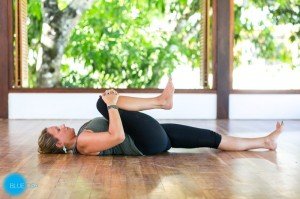
- Hug the knees into the chest, draw the forehead up to meet the knees.
- As you exhale allow the knees to fall to the right, T the arms with the palms facing upwards and gaze to the left for SPINAL TWIST / (5mins).
- On an inhale, return to centre and exhale knees left / (5mins).
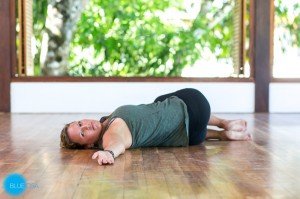
- Return to CONSTRUCTIVE REST / (3mins).
- Extend the right heal to the sky, bend the knee and bring the right ankle of the left knee. Hug the left knee into the chest for reclined EKA PADA RAJAKAOPOTASANA (half king pigeon) / (5mins).
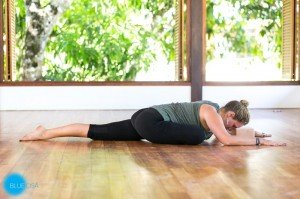
- Hug the knees into the chest and roll over the right. Place a small cushion under the head and a block or bolster between the thighs (10mins).
- Help yourself up to a comfortable sitting position, place a cushion or bolster under your sit bones and breath slowly / (5-10mins).
- Roll over the ankles to all fours (hands and knees). Bring the toes together, separate the knees. Place the bolster length ways between them. Sink the buttocks towards the heals and drape the chest over the bolster for supported BALASANA / (5-10mins).
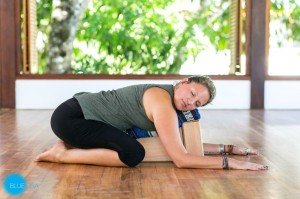
- Gently remove the props and shift the belly onto the floor. Separate the feet inline with the long, outside edges of the mat and turn the toes out, heels in for CROCODILE, making a cushion for your head with your hands / (10mins).
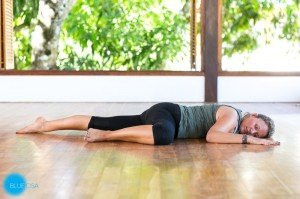
- Still on your stomach, slide the knee so its in line with the hip joint and the thigh is at 90 degrees to the body for BABY / (5-10mins).
- Switch sides.
- Return to BALASANA (child) for a few breaths.
- Move through all fours, and slide the right knee up towards the right wrist. Keep the right ankle flexed, to protect the knee and keep the heel close into the groin when you first start this posture (as it gets more comfortable you can practice moving the heel further out and eventually aiming the shin at 90 degrees to the body). If you need it, put a prop under the right buttock. Use the bolster as a pillow or prop the elbows onto the bolster. / (5mins)
- Switch sides, transitioning slowly.
- Find your way to a seated position, with the legs extended in DANDASANA (staff pose) / (3mins).
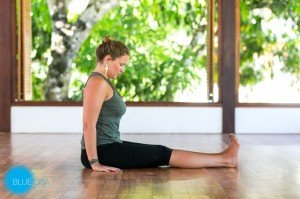
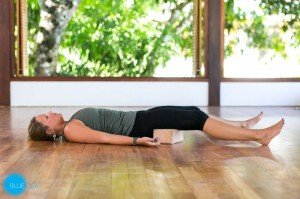
- To come out take a stretch from head to toe and circle the ankles and wrists.
- Roll over to your right side and help yourself slowly up to sit.
- Take 10 slow, regulated breaths to breath yourself back into the present moment.
Do this restorative yoga practice for stress and fatigue at the beginning or end of the day when going through periods of fatigue or stress, or anytime you feel you need to unwind.
How do you deal with stress and fatigue? Have you tried a restorative yoga practice before?
Pin this post for later!
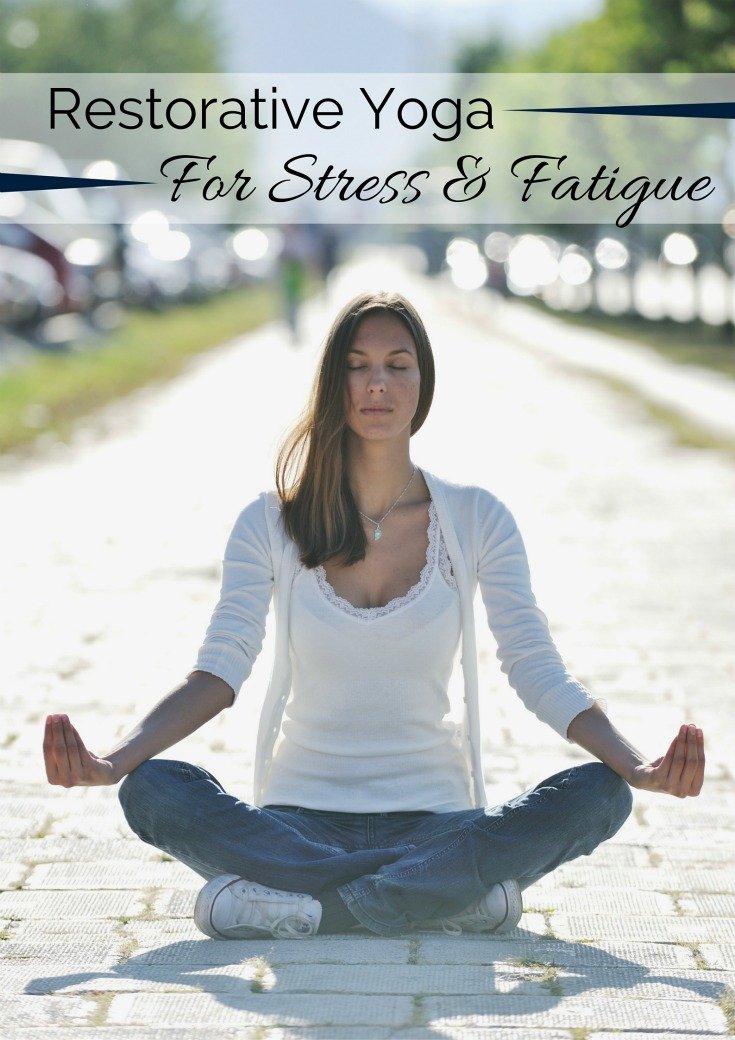
About the author
Katherine is a global nomad, a free spirit, a wild warrior yogi on a quest for her own truth; part of a new generation of women who are wild, wise, authentic and free, who has chosen to dismiss what society has dictated and instead pursue my own destiny.
Katherine is a devoted student of yoga, with a travel addiction. She is a yoga teacher, an ayurvedic chef, a life-coach, a self-confessed foodie and adrenaline junkie with a healthy thirst for tequila margaritas and moving her body in rhythm with a banging baseline.
She had written her own cookbook ‘Nourish. Healing meals at Moses’ for Vale De Moses in Portugal and co-authored ‘Voila. Cuisine avec Maria’ for Blue Osa.
Katherine’s writing is dedicated to inspire positive change in you through yoga, nourishment and unapologetic flourishing fun.


